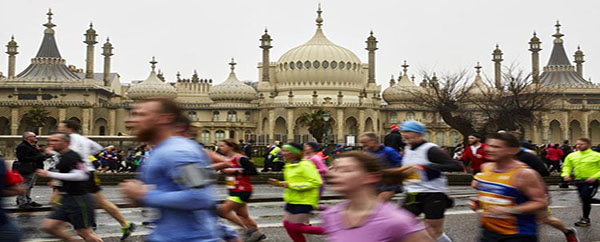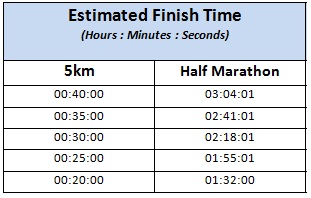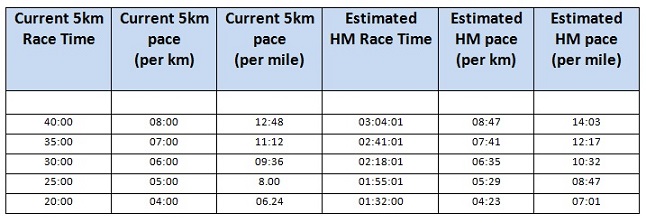Half Marathon Preparation

For many runners, finding the time to train for a half marathon can often be more realistic than that needed for a full marathon. Also, there’s less chance of alienating friends, falling out with family members and being late for work. So, without further ado, let’s take a look at some of the most important elements of training for a half marathon.
Estimated Finish Time
Whether this is the first time you run a half marathon or a long awaited opportunity to try and beat your PB (personal best), the key word from this point on is preparation. Successful preparation relies on having a clear goal. “I just want to finish” may have been what gave you the confidence to sign up, but in our experience one of the most important ways to avoid injury and enjoy the day is calculate your estimated finish time and organise your training around it.
Your estimated finish time can be calculated easily from your current 5k time (3.1 miles). The hugely popular parkruns (free, weekly, 5km timed runs all over the UK), provide a wonderful, fun orientated opportunity for you to get used to running in a timed event and more importantly see how long it currently takes you to run 5k. This table shows an estimated finish time for a half marathon based on your current 5k time, presuming you do a suitable 16 week training program.
These estimated finish times are created using surprisingly accurate scientific logarithms. Some sites online provide calculators where you just enter your recent 5k time, hit the button and bingo… there’s your estimated finish time for a half marathon. Check out the Runner’s World Race Time Predictor by clicking on the link.

Estimated Race Pace
Once you have an estimated race time, you can now calculate your estimated race pace. This is important because despite what you may think, training for a half marathon is not just about running a bit further every time you go out until you finally reach 13.1 miles. To be able to last the 13.1 miles without fatiguing, your weekly sessions are going to use different paces.
Pace is measured in how many minutes it would take you to run a mile. Most of us could probably run 100 metres in under 15 seconds, equivalent to a 3 minute 45 second mile pace. However, only a handful of runners in the world can maintain that pace for a whole mile. 58:18 minutes, by Kenyan Abraham Kiptum on 28 October 2018 at the Valencia Half Marathon
Elite runner Abraham Kiptum of Kenya maintains a 4 minute 28 second pace for 13.1 miles, which is why he holds the half marathon world record of 58 minutes 18 seconds. Joyciline Jepkosgei of Kenya runs a half marathon at 4 minute 35 second pace, setting the female half marathon record of 64 minutes 51 seconds.
Below you will see that we have expanded the original table to include your current 5k pace (in miles and km) and corresponding estimated race pace. The pace you run your half marathon will obviously be slower than the pace you run 5k in. This is massively important in half marathon preparation as many new runners merrily set off at their 5k pace thinking that eventually they will be able to maintain that for 13.1 miles. It doesn’t happen that way. In fact, you may be pleasantly surprised at how slowly you need to do your long run sessions (see on)!
You can also calculate your estimated race pace by using an online calculator. Just enter your estimated race time, hit the button and bingo… there’s your estimated race pace. Check out the pace calculator at Coolrunning by clicking on the link.

Building Your Training Plan
Armed with your estimated race time and pace, you are already far better prepared than a lot of runners going into a half marathon. Let’s now see how all of this fits into building a training plan. A quick search on Google results in a multitude of training plans offered for all race distances; plans for beginners, intermediates, advanced; plans lasting 10 weeks, 14 weeks, 18 weeks; plans for the busy girl, busy mom, super dad… the list goes on. There is no magic generic formula that will provide you with the perfect training plan.
How you best organise your training, the time of day, choice of day, order of days, quantity and position of rest days, etc. is individual to you. What is important is that you choose a plan that incorporates a suitable combination of aerobic fitness training (long runs) and neuromuscular fitness training (shorter mid week runs).
- The Long Run
Getting the miles in is obviously a vital part of training for a half marathon. Distance running relies on having a strong aerobic system; the greater your ‘aerobic capacity’, i.e. the ability of your body to use oxygen (also known as VO2max), the more energy can be created. However, many runners perform their long run way faster than their Estimated Race Pace. As a result, this are not preparing for race day and they are unnecessarily increasing risk of injury. - Mid Week Runs
Your mid week runs are where you now up the pace, taking your ‘tiredness level’ up to the 7’s and 8’s out of 10. Interval sessions, for example, in which you run your fastest possible half mile followed by a slower paced recovery mile, and repeat that combination a few times (depending on your level of fitness). Hill work provides another great midweek workout and can be a very effective way of building up neuromuscular fitness, i.e. the ability to keep your legs moving in an efficient manner even when fatigue sets in as you near the finish line on race day.
Warm Up, Cool Down, Conditioning
For most people, going straight into a challenging exercises session can shock the body and increase risk of injury. It therefore makes sense to ease yourself into your running session gently. Depending on your level of fitness & the type of training session you are going to do, this may just mean a brief walk or jog before you start running at your training pace for that particular day. If your training session is going to be more demanding, you may well want to spend longer warming up, include some brief speed intervals to get your body ready to exert itself at that intensity, or even the lunge matrix to help get your body ready for the demands. What is not generally necessary or helpful is spending time on static stretching (holding stretches for 15 seconds plus). You’re getting your body ready to move and use the range of motion needed for running, so why would we bother trying to touch our toes in a running warm up? Some studies show that static stretching may even reduce our running economy!
As far as the cool down goes, the same as the above applies, but in reverse. In other words, we don’t want to suddenly finish a hard workout and go immediately to not moving at all, or straight back to the stresses of life and work. The cool down should therefore incorporate a gentle return to normal heart rate whilst walking, or lying down and gently rotating & opening/closing joints. Again, there is little point to holding long static stretches in positions we have not even used during the run. There is no evidence that stretching can reduce running injury or reduce soreness following exercises, despite what many websites and professionals still recommend. Have a look at our H.E.L.P article on a suggested runners cool down routine.
Need Help?
If all of this has sounded a little bit daunting, don’t let it be. You are welcome to email us (matt@runchatlive.com or use contact form at bottom of homepage) any concerns you may have, and book in for either an online consultation or when possible a face to face meeting. We can help with any of the following:
- Creation of a training plan
- 1:1 or group strength conditioning
- 1:1 or group outdoor coaching
- Injury Treatment
- Rehabilitation
- Running Gait Analysis


0 Comments